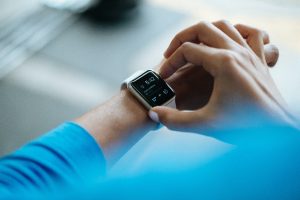
Getting the heart rate up without impact training
To increase cardio fitness and burn calories we need to get the heart rate up.
If you want to do this without asking sore knees to take the impact of landing (jogging, etc) then you need to use the big prime movers – glutes, quads, hamstrings. This involves some squatting and some lunges.
To get the most out of these exercises,
you need to recognise two things
- ways in which you are avoiding the work – and letting the knees take the brunt
- ways in which existing imbalances are being recycled
don't avoid the work! (be good to your knees)
The feeling of working harder is usually met with our minds as unpleasant. This is when we subconsciously find ways to move away from this unpleasant feeling.
If you start off doing a few good lunges, where you certainly feel your muscles tire and your breathing start to labour and then begin to resist this, the torso leans forward over the knees and the back starts to round. The knees take the brunt.
BE AWARE OF THIS CHOOSE TO STICK WITH THE WORK
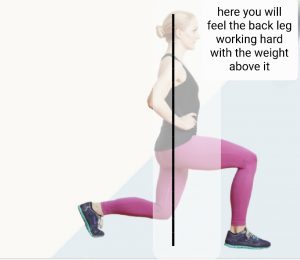
Not resisting the work
Choosing to stick with the work means getting used to the feeling of a muscle working. It is filling with blood! Be willing not to resist this feeling. You are putting time in to your programme so get the most out of it.
So in lunges, for example keep the torso over the back leg and you will feel it in the thigh of the back leg. At the same time, the burden is shared with the front leg muscles and glute muscles. Have the front foot firmly on the ground.* Push through this foot to drive back up, powering up the back of this leg and the glutes. This feeling of work is what you are going for.
* If you struggle to balance, with the front toes scrunching up to cling to the floor, have a hand on the wall for support or hold on to some TRX straps if you are at the gym.
reinforcing imbalances
Imbalances definitely can occur from work-avoidance but also from old injuries, anticipating pain, posture, developing favourite exercises or stretches – anything that makes one muscle too long/tight/short/weak in proportion to the others surrounding a joint.
A short or dominant muscle will fire up first, leaving the others to get weaker. For the movements involved in the big prime mover exercises – squats and lunges – the main things to look at are
- feet/ankles
- glutes
- core
feet/ankles - alignment to knee
I can’t express how important this is. Your feet set up your lower leg-knee alignment.
If your ankles roll in or out (over-pronation or over-supination) your foot-knee alignment will be off. This can be addressed with stretching/strengthening and you can purchase trainers for over/under pronators. Uneven wear on your trainers is one indication of this imbalance.
There is more info for you here (you will be directed to the university foot and ankle institute)
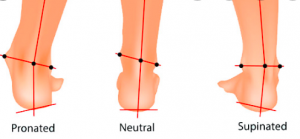
Body in Balance
Even if yoga really isn’t your thing, I still recommend checking out this video from my Pure Yoga Training. The 3 POINTS on the sole of your foot are absolutely something you bring into squats and the front foot of lunges to activate core, hamstrings and glutes.
Glute work
To really get into your squat and lunge technique you need to appreciate your glutes! Your glutes need to lengthen (eccentrically) as you sit back. I love this video clip on muscles at work – as a muscles lengthens to allow movement, there is an opposite force within, just creating enough tension to control this movement. As you sit back, your glutes lengthen under control, they are ready to contract to as you return to standing.
the two main reasons this doesn't happen
- TRUST
- TIGHTNESS
I could write an essay here, but I won’t.
TRUST begins with the feet as you sit back. Often the toes are scrunched into the floor to stop the feeling of falling backwards (which is the role of the core). This generates tension down the front of the lower leg and the small hip rotators (often with the tailbone rolling under)
- FIND THE 3 POINTS OF THE FOOT, (Body in Balance video above) SIT RIGHT BACK, ALLOWING THE GLUTES TO LENGTHEN UNDER TENSION. This foot action should also ACTIVATE the core.
TIGHTNESS This could be that the quads are so tight that this very tightness controls most of the sitting-back action. It could be that the small hip rotators are so tight that they activate first. There are many muscles at play here.
Take your legs and hips through stretches which target each muscle/group and make a dedicated stretch time to these areas part of your workout. You will need to go through
- piriformis stretch
- hamstring stretch
- glute max stretch
- TFL stretch
- adductor stretch
Core
Squats and lunges are also a core workout. Your core keeps you torso upright and helps to keep your hips level – for knee health.
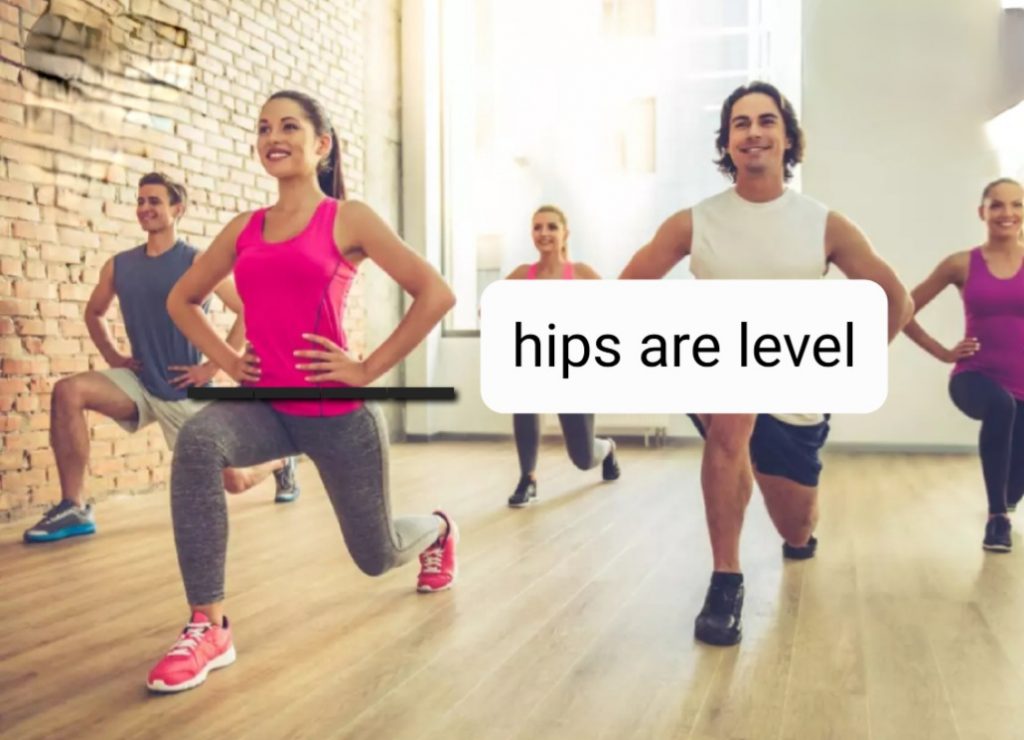
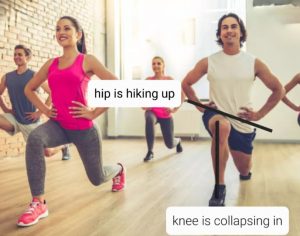
The hip hiking here is both from a lack of core work and a lack of work in general. There is a lot of sinking into the groin, (Also the knee usually collapses in from either a weak ankle and/or weak gluteus medius).
Foot awareness would bring this movement pattern into your awareness. Recognise that depth of lunge is not foremost here; it is using your muscles in balance with each other. Give the core its role, along with the inner and outer thigh, and – of course – the feet. This is what will develop the strength to go deeper as you are ready.
